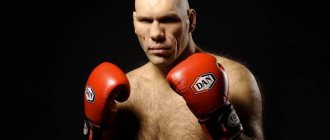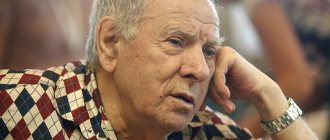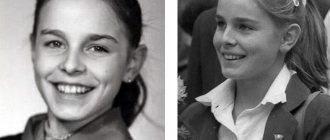Ole Einar Bjoerndalen is a famous Norwegian biathlete.
He was born on January 27, 1974 in the Norwegian town of Drammen. From an early age, like all Norwegian children, he knew how to ski well. At school, he did not strive to get good grades, but devoted all his time to sports. Among his friends he had the nickname Fat Man, although he was not fat, but had a large face.
At first Ole played handball, then tennis, then football. Many years later, Bjoerndalen admits that at a young age he smoked and drank alcohol, but decided to change his life.
At the age of 12 he begins to seriously engage in biathlon. Since then, he has not smoked a single cigarette or drunk a drop of alcohol.
At first, Bjoerndalen showed terrible results in shooting, but, having set himself the goal of learning to work brilliantly at the line, he soon became one of the best shooters on the team.
Biathlon career
Already at the age of 18, the talented Ole Einar makes his debut at the Biathlon World Cup. In his first season, Bjoerndalen failed to win any medals. In the winter of 1994, the coaches, seeing all the makings of a future biathlon star in the young Norwegian, took him to the Olympic Games. But Ole didn’t make it to the podium there either. Lack of experience took its toll.
On December 8, 1994, Bjoerndalen won the World Cup prize for the first time. In the sprint race of Bad Gastein, Austria, Ole Einar came second, losing 14 seconds to his compatriot Jon Aage Tyldum. Bjoerndalen's first victory took place on January 11, 1996. In the individual race at the third stage of the World Cup in Anterselva, Italy, the Norwegian shot to zero and was able to win.
In the 1996 season, Bjoerndalen became one of the strongest biathletes on the planet. At the end of the season, Ole Einar took second place in the overall standings, losing 11 points to German Sven Fischer.
At 24, Bjoerndalen becomes an Olympic champion. In Nagano, Japan, on February 18, 1998, he won the sprint, one minute ahead of Frode Andresen, who came second in that race. In the same year, Bjoerndalen wins his first World Cup, taking first place in the overall standings.
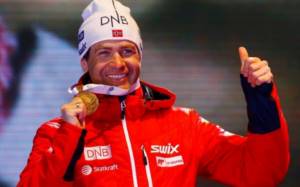
In 2002, Ole Einar, of course, went to the Olympic Games in Salt Lake City as one of the favorites. But no one could imagine what incredible results he would show. Bjoerndalen won all three individual races: individual, sprint and pursuit, and then won victory as part of the Norwegian team in the relay. Thus, he became a five-time Olympic champion.
In the post-Olympic season of 2002/03, Bjoerndalen took the World Cup for the second time, and repeated the success in 2004/05 and 2005/06.
Ole failed to win gold medals at his third Olympics, but he came second twice and third once.
In the 2007/08 and 2008/09 seasons, Bjoerndalen won two more Big Crystal Globes - the trophy for winning the overall World Cup, and then things started to decline. At the 2010 Olympics, the first two races for the “King of Biathlon” turned out to be failures - first seventeenth place in the sprint, and then seventh in the pursuit. In the individual race, Ole pulled himself together and showed the second result. But after 3 days in the mass start, the titled Norwegian missed 7 times. Such shooting did not allow Bjoerndalen to take a more or less decent place. As a result, 27 results.
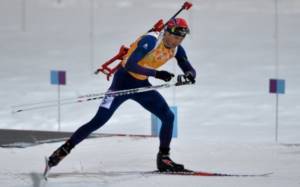
In 2011, Ole was injured and his results deteriorated further. In the 2011/12 season, 16th place in the overall standings, and the following year even 22nd. In the summer of 2013, Bjoerndalen announced his intention to retire after the Olympics in Sochi. Ole Einar prepared for his last Games using an individual program.
On February 8, 2014, to everyone’s surprise, the 40-year-old Norwegian became a 7-time Olympic champion. Despite the miss, Bjoerndalen wins the sprint. After 10 days, the Norwegian won his eighth gold in the mixed relay. In the overall standings at the end of the season, Ole becomes sixth. He decides to continue competing until the 2021 home World Championships in Oslo.
In the summer of 2014, Bjoerndalen trained unusually. He bent his sticks at the top. He found that this way a more powerful repulsion was achieved. This allows you to win a few cherished seconds at a distance. He started the 2014/15 season with these sticks. He was soon joined by several biathletes, including such celebrities as Swede Fredrich Lindström and Belarusian Daria Domracheva. The next season, Ole Einar abandoned this “invention” and began another experiment - super-light sticks.
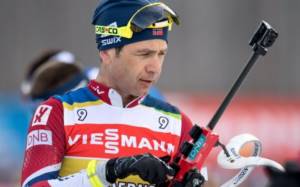
At the World Championships in the Norwegian capital, the “King of Biathlon” performed excellently: two silvers, gold and bronze. Bjoerndalen announces that he has no intention of retiring just yet.
The twenty-fifth biathlon season was Ole Einar Bjoerndalen's last. The best result is 18th place. The 44-year-old biathlete failed to qualify for the Olympics in Pyeongchang, Korea, but Bjoerndalen went there as part of the coaching staff of the Belarusian national team.
On April 3, 2021, the biathlete made the final decision to end his sports career.
On December 29, 2021, Ole Einar Bjoerndalen took part in the “Christmas Star Race” - an annual biathlon show. This race was the last official start for the Norwegian. Bjoerndalen performed in tandem with his wife Daria Domracheva.
Ole Einar left the last shooting third, but was soon overtaken by the German Benedikt Doll. A few meters before the finish, Doll stopped. After waiting for Bjoerndalen, the German gave him his hand and crossed the finish line with him.
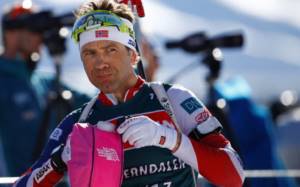
Ole Einar Bjoerndalen now
In 2021, after a scandal involving positive doping tests among Russian athletes, Ole Einar spoke out in defense of the Russians. The Norwegian champion emphasized that WADA’s practice of forcing national anti-doping agencies to recognize the existence of state systems to support athletes’ doping makes any athlete vulnerable and does not guarantee that there will be “no scratches” on the doping test of each Olympic participant.
At the end of the year, the coaching staff of the Norwegian national team approved the list of biathletes who were included in the national team athletes to participate in the World Cup stages held in Germany. In addition to Ole Einar Bjoerndalen, the men's team included Lars Helge Birkeland, Vetle Sjåstad Christiansen, Erlend Øvreng Bjøntegård, Johannes Bø, Tarjej Bø, Henrik LAbeLund and Emil Hegle Svendsen. Based on the results obtained during the course in Oberhof and Ruhpolding, a team will be formed to participate in the Olympic Games in Pyeongchang.
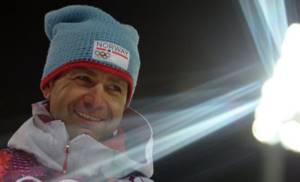
Biathlete Ole Einar Bjoerndalen
Ole Einar Bjoerndalen did not fulfill the requirements established for future representatives of the Norwegian team at the Olympic Games. In the first sprint, the biathlete came 52nd, and finished 36th in the pursuit race. Thanks to the victory in the relay race at the stage in Hochfilzen, which took place at the end of 2021, the athlete’s overall ranking reached only 40th place, which is not enough to participate in the Olympics. The necessary conditions have already been fulfilled by two team members - champions Tarjei Boe and Johannes Boe.
The biathlete hoped to make up for lost time and get to Pyeongchang. However, the young athletes turned out to be more effective, and as a result, Ole did not qualify for the Norwegian Olympic team for the first time in many years. He came to Pyeongchang as a consultant and coach of the Belarusian national team, rejoicing at every victory of his players.

Ole and Daria in Pyeongchang | facebook.com/OleEinarBjoerndalen
In April 2021, the legendary athlete Ole Einar Bjoerndalen announced his retirement. According to the Norwegian, he could still “run,” but doctors advised him to quit sports due to heart problems.
Ski race
In addition to competing in biathlon, Bjoerndalen is a good skier. He took part in ski competitions. He participated in the World Ski Championships twice, but failed to reach the top ten, finishing in 11th and 13th places. In the World Cup, Ole Einar became a silver medalist twice. The first time this happened was on November 25, 2001, and the second time on December 22 of the same year. On November 18, 2006, Bjoerndalen won the 15-kilometer race in Gällivare, Sweden.
In relay races, Ole Einar won two awards - bronze in 2003 and silver in 2006.
Victories in individual and team competitions
Bjoerndalen is the most titled biathlete in history. He has many awards to his name. The Norwegian has 96 victories in personal biathlon races, and his last victory became a kind of record.
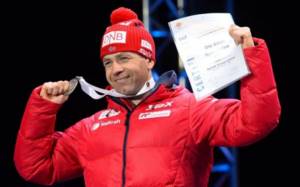
On December 2, 2015, he became the oldest winner of the Biathlon World Cup in the history of the competition. At the time of “victory” in the Ostersund individual race, Ole Einar was 41 years, 10 months and 5 days.
In team disciplines, Bjoerndalen won 41 times.
In total, the great biathlete has 137 victories, which is a record that most likely no one will be able to beat.
Biathlete Bjoerndalen: biography
The future champion and biathlon “King” Ole Einar Bjoerndalen was born on January 27, 1974 in the Norwegian city of Drammen. My childhood years were spent in Simostrand. The parents ran a farm; they had five children in the family, three sons (Ole Einar is the middle one) and two daughters. Zodiac sign - Aquarius, according to the eastern horoscope - Tiger.
As a child, the future champion spent more time not studying, but playing sports in sections. He was interested in football, cycling, athletics, and javelin throwing. He achieved good results in the 3,000 m race. But then, at the age of 10, he decided to follow in the footsteps of his older brother Doug, who was already involved in biathlon.
Ole Einar even then differed from his peers in his fast skiing and was immediately noted by the coaches, who sent the guy to study at the Norwegian Sports Academy. He is a member of the Norwegian biathlon team from 1992 to the present.
How old is the biathlete? There is no need to ask Bjoerndalen about this, since he does not like to talk about personal things. But it is easy to calculate that Ole Einar is currently 42 years old. The athlete weighs 65 kg and is 179 cm tall. In addition to Norwegian, he knows three more languages: Italian, English and German.
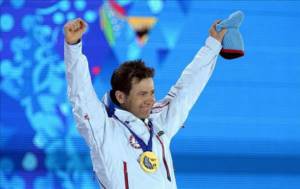
Results in the overall standings of the small and large World Cups
In the overall World Cup standings, Bjoerndalen won 6 times. He came second the same number of times.
Ole Einar has twenty Small Crystal Globes. This award is given to biathletes for victories in the overall standings of a particular discipline. In nine seasons, the Norwegian was recognized as the best in the sprint. He won the pursuit and mass start classifications five times each and won the individual race standings once. This discipline is the most unsuccessful in the history of Bjoerndalen.
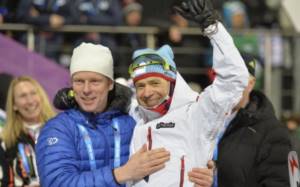
Interesting facts from the life of a champion
Our champion takes great care of his health, protects himself from viruses and maintains cleanliness everywhere, so he always takes a vacuum cleaner on trips and very rarely shakes hands. He picked up the habit of carrying this device from the older “collectors.”
In April 2014, to prevent unexpected illnesses, create optimal conditions for the training process and recuperate, he bought a 20-ton van. The cost of such a mobile home was estimated at 2 million crowns.
In 2021, in Moscow, our hero, together with the Certina company, presented his own collection of watches.
By his nature, he is distinguished by modesty and phlegmatism. He has a sense of humor and self-irony.
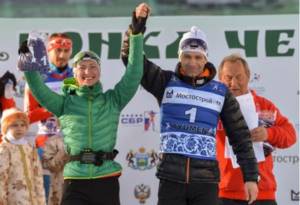
Life after leaving professional sports
Bjoerndalen devoted a quarter of a century to biathlon. He spent 25 seasons on the World Cup circuit, finishing on the podium 261 times.
It’s not for nothing that Ole Einar is called the “King of Biathlon”, because he was and remains the strongest biathlete in history, who even at the age of 40 fought for prizes and was able to win. It seemed that he had always been and always would be, and when it was time for him to leave, all biathlon fans were upset.
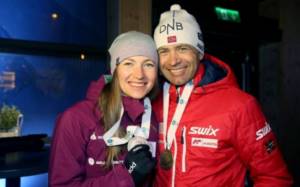
Bjoerndalen's era is over, but he himself decided not to stray far from biathlon and became a journalist on one of the Norwegian sports channels. Now Ole Einar conducts interviews and films while visiting World Cup stages, where he himself recently performed.
A coaching career has not yet attracted him, although he has received more than once offers from various national teams, including the Russian one.
As Bjoerndalen says, now his family comes first. In 2016, he married the famous Belarusian biathlete Daria Domracheva, and on October 1 of the same year they had a daughter, Ksenia.
Personal life
The most titled biathlete in the world willingly talks to journalists about sports, but is reserved in comments regarding his personal life. Bjoerndalen does not hide the fact that such questions are unpleasant.
Ole Einar lived for six years with Italian biathlete Natalie Santer. The young people met in 1998, liked each other, met infrequently - the busy sports schedule of both did not allow it. Ole and Natalie got married in 2006 and separated in 2012. There were no children in this marriage.

Daria Domracheva and Ole Einar Bjoerndalen
The biathletes did not comment on the reasons for the divorce, but there was information in the press that the divorce from Natalie took place because of Ole Einar’s passion for the Belarusian biathlete Daria Domracheva. The athlete traditionally did not comment on information in newspapers, but since 2010, after the Olympics in Vancouver, athletes have often been seen together.

Ole Einar Bjoerndalen with his wife and daughter
In July 2021, Ole Bjoerndalen spoke on his personal Instagram page about his wedding with Daria Domracheva. In October 2016, the wife gave birth to a daughter. Soon, a photo with his wife and a baby stroller appeared on the athlete’s account.

